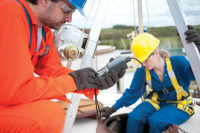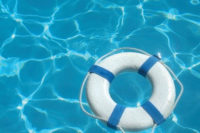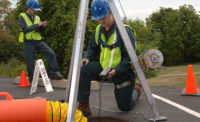I’ll start by reminding everyone that the law that governs confined spaces in general industry is 29 CFR 1910.146, Permit Required Confined Spaces. There is a similar rule for the shipyard industry, 29 CFR 1915.7 and a proposed rule 29 CFR 1926, Confined Spaces in Construction. Each of these laws generally has the same intent, which is to protect workers when they enter confined spaces. They lay out training guidelines, entry procedures and, in most cases, explain the hazards associated with entry.
Where the information falls short is the personal experiences of workers who actually enter the spaces to do the work and the supervisors who oversee it. On-the-job training is a valuable asset that needs to be shared more often.
Having entered confined spaces before, here are a few things I’ve learned and want to share:
Did you know atmospheric pressure can act as an invisible lid?
Atmospheric pressure, or high pressure, is often associated with good, clear weather conditions. It is also responsible for holding gases that are known to be lighter than air into confined spaces, just as a manhole cover would do. To explain this, I’ll illustrate my mining experience.
At every coal mine there is a barometer located in the safety office. This is monitored for changing conditions, typically low pressure associated with a cold front that may be approaching. When there is a severe drop in pressure, more methane is liberated from the mine. So, as high pressure holds the methane gas back, low pressure allows more to escape. For instance, when smoke leaves a chimney in the winter months and travels at a 90º angle, this is due to an unseen ceiling holding the smoke down. Regarding confined space entry, that “invisible lid” can be dangerous in that gas sampling may be ignored because the entrant assumes all of the combustible gases have escaped.
Do you know when combustible and flammable gases can be detected?
The next tip starts with a question I always get asked when conducting training in the field: “Why am I seeing a combustible gas reading on my instrument now (after lunch) but I didn’t this morning?” A common misunderstanding about combustible or flammable gases is when they can be detected. The reason I use both terms, “combustible” and “flammable,” is very important. Here is information from the NFPA regarding the two.
Definition and classification of flammable and combustible liquids are addressed in Section 1.7 of NFPA 30. A flammable liquid is defined as a liquid whose flash point does not exceed 100°F, when tested by closed-cup test methods, while a combustible liquid is one whose flash point is 100°F or higher, also when tested by closed-cup methods. These broad groups are further classified as follows:
• Class IA - Flash Point less than 73°F; Boiling Point less than 100°F
• Class IB - Flash Point less than 73°F; Boiling Point equal to or greater than 100°F
• Class IC - Flash Point equal to or greater than 73°F, but less than 100°F
• Class II - Flash Point equal to or greater than 100°F, but less than 140°F
• Class IIIA - Flash Point equal to or greater than 140°F, but less than 200°F
• Class IIIB - Flash Point equal to or greater than 200°F
A very simple example is kerosene. Kerosene has a flash point of 100ºF, which means that kerosene will not give off any vapors that are detectable with a combustible meter until its temperature is close to that 100ºF mark. If you have ever used a kerosene lamp or a backyard torch, when lighting it you would place a match up to the wick and start to warm the kerosene. White vapors start appearing and finally a flame would appear. It is those same vapors that are ignited that can also be detected by a combustible gas meter.
Gasoline, on the other hand, is much different. Its flash point is -45ºF. Gasoline will always have vapors that can be detected. Styrene’s flash point is somewhere in the middle of these temperatures with a flash point of 88ºF. That leads us back to the question of when combustible and flammable gases can be detected. The answer can be found in knowing what material(s) may be present, and when they will produce vapors that can be detected. A great tool to assist you with this information is the NIOSH Pocket Guide to Chemical Hazards. It has 677 chemicals listed in its 2005 edition with information on exposure limits, chemical and physical properties, synonyms and even emergency treatments.
Are you prepared to enter the confined space?
One common mistake I see when people are preparing to enter a confined space is the sampling time it takes to properly detect the atmospheric conditions of their space. First, you need to understand the tools used for this task. Most instrument manufacturers use electrochemical sensors for detection of oxygen and toxic gases, and Wheatstone-bridge catalytic sensors for combustible gas detection. In both cases, the methods of detection are not instantaneous. Electrochemical sensors need time for the chemical reaction to occur. That is the sensor’s ability to change the chemical reaction into a form of electricity that the instrument can display. The readings are in either parts per million (PPM) for toxic gases or percent by volume for oxygen. The catalytic sensor burns the gases on its surface and requires the temperature to stabilize for a proper display of information.
A typical response in both cases is referred to as “T90” or the time it takes to see a 90 percent response. Finally, allow two minutes for complete sampling. You must check with your instrument manufacturer of choice regarding their guidelines for sensor response. Using a remote sampling device (pump) along with your instrument is the only sure way of knowing you are getting the information you need to safely enter a confined space.
Learn before you enter
Experience is a great teacher; however, when dealing with confined spaces and their inherent dangers, learning those dangers before you enter may save your life. Look to those people who have experience and listen, then put their knowledge to work for you, and finally train, train and train some more.



